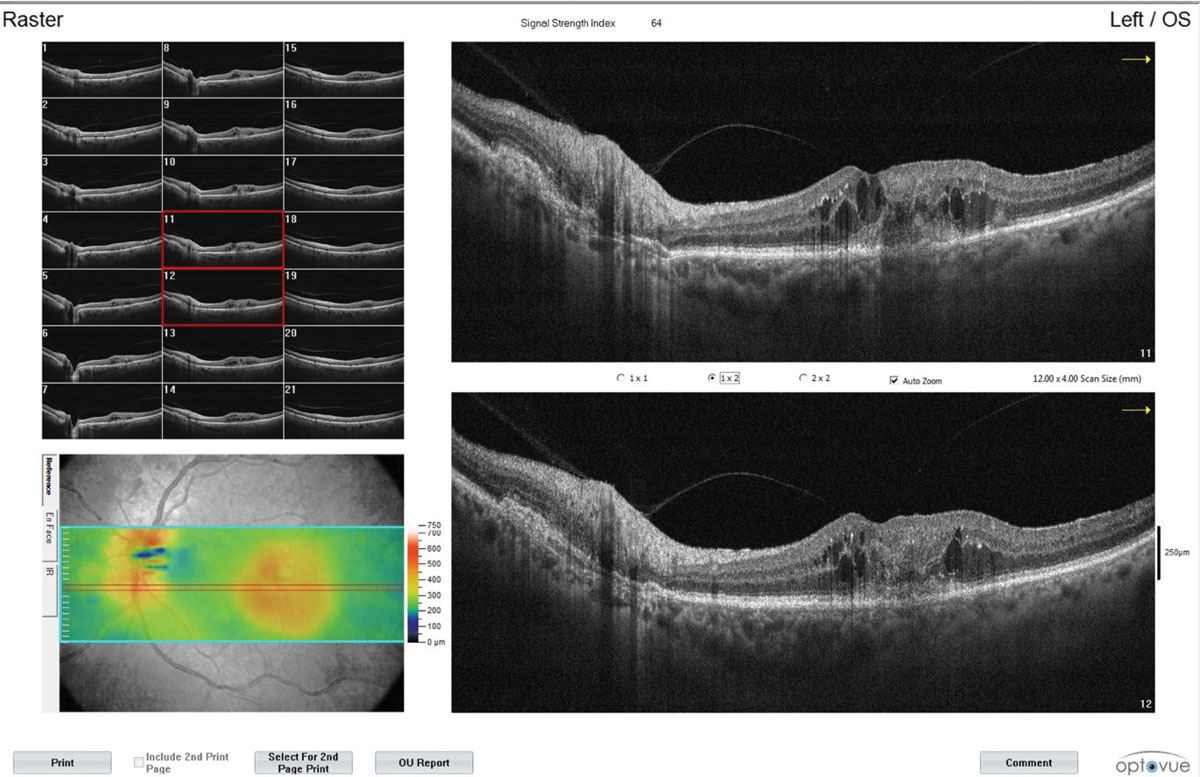 |
| Retinal fluid decreases the effectiveness of anti-VEGF injections. Photo: Steven Ferrucci, OD, and Brenda Yeh, OD. Click image to enlarge. |
One of the ways that anti-vascular endothelial growth factor (anti-VEGF) improves visual outcomes in patients with neovascular age-related macular degeneration (nAMD) is by resolving subretinal fluid and reducing retinal thickness. The accumulation of fluid in patients with nAMD acts as a reliable disease marker, with intraretinal fluid (IRF) achieving a stronger correlation with worse visual outcomes than subretinal fluid (SRF).
Researchers recently analyzed the data of two clinical studies and concluded that early residual fluid (ERF)-free status may be a good indicator of a patient’s response to treatment. The team defined ERF as “the fluid that remains after the loading phase and subsequent visual outcomes through follow-up of two years or more in patients with nAMD following anti-VEGF treatment.”
Data was gathered from both the double-masked Hawk and Harrier studies. Patients received either brolucizumab 3mg, brolucizumab 6mg or aflibercept 2mg and were split into two groups (ERF or ERF-free) depending on the presence or absence of ERF at week 12. Every four weeks throughout the two-year follow-up, patients completed SRF and IRF assessments, central subfield thickness (CST) measurements using spectral-domain OCT and visual assessments including best-corrected visual acuity (BCVA).
Of all 1,417 patients analyzed, 1,051 had ERF at 12 weeks and 366 did not. Baseline characteristics were comparable between the groups. Patients without fluid in the ERF-free group had greater improvements in BCVA at every assessment throughout the study period on average.
“From week 12 to 96, patients who were ERF-free had greater least square (LS) mean increases from baseline for BCVA and CST compared with ERF patients,” the study authors wrote. “Greater LS mean differences in BCVA from week 12 to 96 were noted between ERF-free and ERF patients. A greater proportion of patients in the ERF-free cohort reported a ≥5, ≥10 or ≥15 letter improvement and a higher proportion reported BCVA ≥70 letters from baseline to week 96 compared with those with fluid.”
The type and dosage of anti-VEGF administered were not found to affect visual outcomes.
The authors concluded, “Patients achieving ERF-free status following anti-VEGF treatment may have better long-term visual and anatomic outcomes than those with the presence of ERF.” Assessing and monitoring the presence or absence of retinal fluid in nAMD patients may help to predict their response to treatment.
Jhaveri C, Wykoff CC, Khanani AM, et al. Early residual fluid-free status and long-term bcva outcomes: a treatment agnostic, posthoc analysis of pooled Hawk and Harrier data. Am J Ophthalmol. October 8, 2021. [Epub ahead of print]. |


